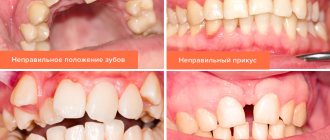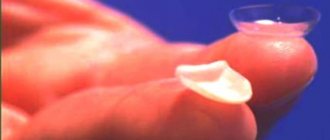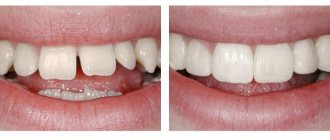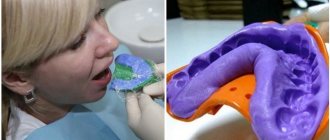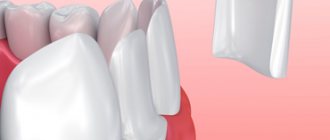May 1, 2020 Last revised: September 12, 2020 Veneers and Lumineers
In order to give teeth an aesthetic appearance without compromising their integrity, modern dentistry offers the use of lumineers - thin linings that are manufactured using modern technologies using porcelain. Lumineers are one of the types of veneers. They are distinguished by a unique design, which allows their installation without grinding the tooth enamel. How is lumineers installed and what is it advisable to know about the process of teeth straightening with lumineers?
Lumineers - characteristics
The installation of lumineers is one of the most delicate, gentle and reliable tooth protection and reconstruction. Their use allows you to hide such dental imperfections as minor chips of the enamel, its darkening, pits or cracks and the presence of dental erosion. Product characteristics:
- Lumineers are made 0.2–0.3 mm thick, whichever does not exceed the thickness of the eye lens;
- the resulting prosthesis best matches the shape of the tooth in need of reconstruction and its natural color;
- the strength of the structure allows you to avoid the appearance of microcracks on its surface;
- This product has a long service life, which is equal to 20 years of operation;
- If necessary, lumineers can be easily removed without compromising the integrity of tooth enamel.
The production of lumineers takes place in laboratory conditions. The American company DenMat is engaged in the performance of these products. Installation can only be carried out by specialists who have completed training courses and relevant internships at the manufacturer.
Types of modern lumineers
1. Cerinate: these dental onlays are made from individual impressions that were taken when working with each individual patient - the doctor sends the patient’s data to the laboratory of the manufacturing company, which is located in the USA, and then the thinnest plates are sent by mail to their homeland. The end result is unique products that will match the anatomical features of your teeth and create a natural, natural smile. Also, wearing them will subsequently be justified by a high level of comfort, so their production and shipment (which sometimes takes up to several months) is really worth the wait.
2. DUO-PCH: these lumineers appeared recently, so many people ask what they are. These overlays are templates, but they are also created directly in the USA by the same company. Such options for microprostheses, as a rule, are already available in the clinic, which is the official representative of the manufacturing company. And their presence allows you to reduce the time required to obtain an ideal smile, i.e. installation is carried out immediately after the patient’s decision to undergo microprosthetics.
Officially, Lumineers are created by only two companies located in the USA: Cerinate and DUO-PCH. If the clinic offers you other names and models, then keep in mind that you are dealing with a fake - these are ordinary veneers, and the manufacturing companies or the doctors themselves are simply using the original name as an advertising ploy.
Installation Features
Lumineers are installed only on the front teeth from the outside. Attachment to tooth enamel occurs using special strong dental cement. Its peculiarity is to resist the aggressive effects of consumed food and saliva for a long period of time. Thanks to the latest technologies, cement is saturated with a high fluorine content. This has a beneficial effect on tooth enamel, strengthening it while wearing dentures.
Despite the fact that this design can last for many years, many patients are concerned about this issue. What will happen to my teeth if I need to remove lumineers? This structure is easily removed from the surface of tooth enamel using a special tool, without violating its integrity or causing damage to the enamel. This is due to a special procedure for installing dentures, which takes place without grinding the tooth enamel, which cannot be done when installing conventional veneers.
For many patients, another important feature of installing prostheses is that during the procedure there is no need to use a drill or use anesthetic injections.
Installation steps
Now let's take a closer look at how the thinnest ceramic linings are installed and the features associated with this process:
- before starting work, it is possible to make wax or electronic models, allowing the patient to evaluate the result of prosthetics in advance,
- if there are carious cavities, inflammatory processes, deposits in the oral cavity, then before the installation procedure it is necessary to carry out cleaning of plaque and the necessary treatment,
- The surface of the teeth is ground for better adhesion of the lumineers to the supporting units: anesthesia is not required, since sensitive tissues are not affected. There is also no need to carry out depulpation procedures and installation of temporary structures, the shape of the teeth will not change, and the sensitivity of the enamel will increase slightly (and this is only a temporary phenomenon),
- Impressions of the jaws are sent to Cerinate for the manufacture of dentures. The process of sending finished products usually takes about 3 weeks,
- the structures are fixed using a fluorinated adhesive composition, which provides additional protection for the enamel and strengthens it.
Structures can be made in just 2 visits, but the total period of work depends largely on the timing of sending casts and finished structures. Lumineers are most often chosen by patients who primarily need aesthetics and the health of their own teeth without grinding them down.
How is lumineers installed?
The entire installation process contains 2-3 steps. To install lumineers, you will first have to carry out a complete treatment of the entire oral cavity: cure possible inflammatory processes, fill existing teeth defects, eliminate caries. This entire preparatory stage is not included in the cost of the procedure for installing lumineers. Next, after complete sanitation of the oral cavity, the process of installing dentures takes place in the following sequence:
- Impressions are made of both jaws;
- using a special computer program, a smile simulation is created;
- all data is sent to the laboratory where the porcelain onlay will be manufactured;
- The fitting of the product and its installation is carried out already during the second visit to the doctor, but only if all the onlays fit perfectly to the patient’s teeth.
A strong connection of the prosthesis with the tooth surface makes it possible to avoid carious destruction. The tight-fitting onlay prevents harmful microorganisms and bacteria from entering the dental tissues.
Installation process
Microprosthetics is a painless installation of onlays without grinding the enamel. Lumineers are installed on teeth that have been previously treated and cleaned of plaque. The enamel layer is also slightly polished to make the surface as smooth as possible.
So that the patient has an idea of the final type of microprosthetics, computer modeling of the smile is performed.
Lumineers are not installed on all teeth; the maximum number of coatings is 20 pieces.
The onlays are glued to a special dental adhesive patented by Cerinate. It contains fluoride compounds that nourish dental tissues with useful microelements.
The cost for one plate reaches 1000 USD. e. Since there are 10 teeth in the smile zone (upper and lower jaw), microprosthetics will cost 10-20,000 conventional units.
Complications after incorrect installation
Insufficient qualifications of the dentist can lead to incorrect installation of the microprosthesis. The danger is the small gap between the veneer and the gum, in which plaque will accumulate. A favorable environment is created for the development of pathogenic microorganisms, the remains of which disrupt the acid-base balance in the oral cavity. This leads to various complications: gum disease, development of root caries.
Advantages and possible disadvantages of installing lumineers without refining?
If we compare the installation of lumineers with the installation of conventional crowns or veneers, the former have significant advantages:
- no procedure for grinding the tooth, which allows maintaining the integrity of the enamel;
- a minimum number of visits to the dental office, which saves financial costs for each individual appointment;
- painlessness of the procedure;
- no need to install temporary overlays;
- the product cannot be stained with natural or artificial dyes, for example, from drinking coffee, tea, berries, etc.;
- the pads are absolutely safe for the patient’s health;
- do not contribute to the formation of dental caries, but on the contrary, prevent its development;
- it is possible to remove the structure;
- long service life;
- no discomfort when wearing.
Speaking about the disadvantages of lumineers, we can note the high cost of the product. Also, such onlays can visually increase the volume of the tooth. This is due to the fact that during installation the enamel is not turned. This defect will be less noticeable on the patient’s small teeth.
Rules of care
How to keep the linings in their original form, is it possible to use chewing gum and drink coffee? The patient does not have to change his diet or give up anything. Chewing gum will not harm the dentures, since the fixing adhesive provides resistance to mechanical stress. There is no need to crack seeds or chew nuts. Such eating habits are also harmful to the enamel coating. The seeds are first removed from the husk by hand and then chewed with the lateral molars. You can buy already peeled seeds.
After installing ceramic onlays, you need to reduce the chewing load on the front teeth.
It is also not recommended to bite into hard fruits and vegetables. These include pears and durum apples, carrots. Some dentists do not recommend biting off even non-solid pieces of food: it is recommended to first cut them off with a knife and then put them in the mouth. You need to chew food only with the lateral molars, not covered with onlays.
Fibrous foods require special attention: fibers can get stuck between teeth. Therefore, it is advisable to refuse such food or grind it in a blender.
Despite the innovative material’s resistance to food coloring, you should not abuse coloring substances. This applies to the consumption of beets, red wine, strong tea, etc.
You cannot combine contrasting temperatures: first you ate a cold dish, then washed it down with a hot drink. This will subject the material to additional stress and shorten the life of the plates.
Is it possible to smoke with the covers installed? It is better to give up this habit. Over time, the enamel will begin to darken along with the lumineers, but it will no longer be possible to whiten them. Smoking will lead to premature replacement of microprostheses. Smoking often leads to gum recession, and with onlays installed, this process can noticeably speed up.
What to do if you can’t give up cigarettes? In this case, you need to carry out professional cleaning of the oral cavity 2 times more often, that is, once every 3 months.
Hygiene
Cleaning your mouth is no different from regular cleaning. It is necessary to use high-quality toothpaste, and if necessary, it is recommended to use dental floss.
| Toothpaste | Do not use bleaching pastes as they contain abrasives. This will lead to the formation of small cracks on the surface of the linings. |
| Rinse aid | You can choose any rinse aid. For problems with gums - herbal, to strengthen enamel - appropriate. |
| Toothbrush | The brush should only have soft bristles so as not to scratch the mirror surface of the plates. Do not use electric brushes, which may cause the plates to peel off. This applies to the front teeth. Lateral molars can be cleaned with any brush. |
| Irrigator | An irrigator is the best choice for cleaning the oral cavity with installed microprostheses. A jet of water under pressure efficiently cleans the most inaccessible interdental spaces, does not scratch the surface of the onlays, and gently massages the gums. You can add rinses and herbal infusions to the irrigator. |
It is advisable to clean your mouth after any snack. If it is not possible to use a brush, you can simply rinse with water or a special oral fluid. Some patients are confident in the safety of teeth covered with onlays. But this is false confidence: teeth can also be destroyed under plates. Therefore, comprehensive care and careful attention to hygiene will help avoid oral diseases.
Particular attention is paid to the places where the pads come into contact with the gums. It is necessary to periodically rinse the gums with herbal balm to prevent the development of the inflammatory process. In extreme cases, you will have to remove the plates and treat the gums. The danger is posed by gum recession—decay: the edges begin to rise and expose the cervical area of the tooth. This pathology requires thorough treatment.
Can I use dental floss? This oral care product must be used carefully so as not to cause the plates to peel off. How to use thread correctly? Consult your dentist.
Is it possible to have professional teeth cleaning done in a dental office? This procedure is recommended to be performed twice a year, but you should warn your dentist about the onlays.
Prevention of caries is an urgent need for every person. It is necessary to visit the dentist twice a year to have your teeth checked. This will protect against carious damage to the enamel and hard tissues.
In what cases is it recommended to install?
Indications for the installation of lumineers may include:
- The presence of erosion on tooth enamel. Lumineers installed on the front teeth will help hide such changes.
- The teeth have minor chips or their surface has worn away.
- The enamel has changed color or become stained;
- For minor tooth curvatures. Crowns installed for this problem will help visually level it.
- The presence of defects in the form of tremata or diastemas.
- There are crowns on the front teeth that the patient wants to hide.
- Teeth that have been affected by fluorosis.
- There are fillings on the incisors that have changed their color due to the statute of limitations, but are still intact.
- large interdental spaces.
Lumineers without grinding can hide or correct only minor defects. In case of significant violations, they are powerless. Contraindications for installation may include: periodontitis, caries, severe curvature of the incisors, various bite pathologies, bruxism or pathological abrasion of tooth enamel. Although many of these problems can be successfully treated, after which lumineers can be placed.
Indications for installation
In what cases is it recommended to install overlays? There are the following reasons for this:
- achieve a white effect;
- hide cosmetic imperfections;
- replacement for braces (visually straightens minor curvature);
- achieve straight teeth;
- hide small interdental gaps.
If there is a slight curvature of the front teeth, you can do without braces, the wearing of which is associated with great inconvenience. But if you need to correct your bite, then you can’t do without braces.
With the help of lumineers, you can achieve a snow-white smile without the use of harmful whitening products.
With the help of microprosthetics, it is possible to solve the problem of pathological abrasion of enamel: they serve as a protective layer. This procedure is indicated for people with a thin layer of enamel coating and underdeveloped enamel (hypoplasia).
With the help of microprosthetics, you can hide the fillings installed on the front teeth.
Contraindications
This type of aesthetic correction is not available to everyone. Contraindications are:
- bruxism (night teeth grinding);
- chronic gum disease;
- pathology of hard tissues—dents;
- presence of large fillings;
- large chips;
- pathology of the mandibular joint.
Also, cosmetic correction is contraindicated in patients with multiple caries. Onlays are not always installed on pulpless molars, only at the discretion of the dentist.
Some questions that concern patients
Is it possible to install lumineers on so-called dead teeth? Unlike veneers, lumineers can replace traditional crowns.
Is it possible to install onlays if crowns are already installed? Lumineers are installed on crowns, but only when the latter are in excellent condition.
Is it possible to combine ceramic and porcelain onlays? Lumineers, which are made of porcelain, are placed on the front incisors. To save on restoration costs, onlays made of zirconium can be installed on chewing incisors.
But are Lumineers suitable for everyone, or do they still have contraindications?
Like almost any procedure in medicine, installing veneers on teeth also has its own characteristics and contraindications. They are related to the aesthetic side of the issue: very protruding or large front teeth will look even more noticeable when lumineers are installed on them, which will only emphasize the flaw.
The use of lumineers requires special care in cases where the lower jaw strongly deviates from the upper jaw inward, and the teeth seem to be tilted away from the lip. For such patients, the doctor must make the correction extremely carefully so as not to increase the already significant load on the dentition.
Otherwise, lumineers have no contraindications. Sometimes patients, unaware of the intricacies of technology, believe that ceramic onlays cannot be placed on teeth with healed caries, that is, with fillings, but this is not so. Lumineers can help cover such teeth, especially if the filling is different in color from the dentin. They will also hide other imperfections - chips, cracks in the enamel, yellowish or gray tint of the tooth.
Do Lumineers require special care?
Lumineers do not require any special operating requirements. The patient can consume all foods and drinks without fear. These pads withstand food coloring well without changing their color. The strength of the material used allows you to eat harder foods without chopping them first. An exception would be opening bottles and nuts with your teeth.
If we talk about special care, hygiene procedures are carried out 2 times a day using the usual method of brushing teeth. Also, after eating, you should rinse your mouth with warm water.
How do you know if Lumineers are right for you?
It should be understood that installing lumineers in Moscow or any other city is not a quick process, requiring several visits to the clinic. At the first of them, you can ask the doctor to help you decide whether you need lumineers. To do this, the doctor will take a photo of your teeth, then use a computer to simulate a picture that will show the result of installing lumineers as close to reality as possible. If you like everything, impressions will be taken of your teeth and the dentist will send them to where the onlays are made, that is, in the USA. Why there? Because Lumineers are a patented technology, and only a few American laboratories have the right to manufacture them.
How are lumineers placed?
- Before making the structure, the doctor must examine and evaluate the condition of the oral cavity. If necessary, it is necessary to sanitize the oral cavity and teeth, cure caries, replace old fillings.
- The process of installing veneers is simple for the practitioner and painless for the patient. The surface of the teeth is only cleaned and then coated with a special harmless composition necessary for better adhesion of enamel and ceramics.
- Before installing the structure, the working area is limited by a rubber band; thin pads are carefully fixed to each tooth. After fixation, each tooth is illuminated with an ultraviolet lamp so that the material polymerizes. Then the remaining cement is removed.
After installing lumineers on your teeth, it is advisable to refrain from eating for 1-2 hours, after which you can lead a normal lifestyle.
Differences between lumineers and veneers
Pros of lumineers
- Lumineers are thinner (0.3 mm compared to 0.7 mm).
- No additional grinding of teeth is required before installation.
- The installation procedure is painless and therefore does not require anesthesia.
- They do not damage tooth enamel throughout their wearing.
- They can be completely and painlessly removed from the enamel without harming it.
- Longer service life due to tight fit to the surface and the inability to develop secondary caries under the plates (20 years compared to 10 years for conventional veneer plates).
- Makes teeth whiter and brighter.
- Installation requires no more than two visits to a specialist, since there is no need to adjust the plate to the tooth and install intermediate (temporary) structures.
- The installation adhesive contains a large amount of fluorine and other microelements useful for enamel, therefore it additionally strengthens the tooth surface.
- Due to their low thickness and the ability to add special dyes, it is possible to produce lumineers of the most suitable or desired shade.
- Porcelain plates can be installed on teeth, crowns and dentures, making them the most versatile solution to a variety of problems.
Cons of Lumineers
- More expensive. The finest porcelain slabs are custom made only in the United States. It was there that they became most widespread, especially among famous personalities. As a result, Lumineers are sometimes called “Hollywood”.
- They can provoke inflammatory diseases of the gums and increased bleeding, since the installed plate does not always correspond to the size (if the impression is taken incorrectly).
- Less natural appearance due to the greater massiveness of the jaw that occurs when gluing the plates.
- Requires installation on all teeth.
- They are not recommended for installation with unevenly colored enamel due to complete transparency, which will further emphasize the imperfection of the enamel.
Distinctive features of veneers:
- They require replacement after 10 years due to the development of secondary caries or destruction of the cement that was attached to the tooth surface.
- Ideal in terms of price and quality ratio.
- They require additional processing during installation for a tighter fit and a natural look.
- Thanks to their greater thickness, they help correct more serious changes in the dentition.
- They have a more natural look.
- Veneers are either ceramic or composite.
Read more about the disadvantages of veneers
What to choose?
Many people prefer veneers for one simple reason - this type of cosmetic dental inlays is somewhat cheaper, and therefore more affordable, than lumineers, which create a truly Hollywood smile. In terms of aesthetics, veneers are only slightly inferior to lumineers; they also hide tooth imperfections well, do not require special care and last about 20 years.
Some patients prefer veneers because they consider them stronger, more reliable and durable, which is actually not the case, since lumineers, despite their apparent fragility, are equal in strength to classic veneers. Moreover, due to the minimal thickness of lumineers, there is no need to grind off the top layer of tooth enamel when installing them mechanically - bonding (attaching the plates to the teeth) is performed after lightly etching the enamel with acid.
Veneers, among other things, can be made from a material containing one or another component to which a person may have an allergic reaction. And, although this happens in the rarest cases, since all restrictions and contraindications for the use of veneers are taken into account by a specialist in advance, for many this is a reason to opt for more expensive lumineers, which are always made from biocompatible, hypoallergenic materials.
As a result, the patient is free to decide for himself whether to install lumineers or veneers, although the recommendations of a qualified specialist in any case will not be superfluous. An experienced doctor, relying on his practical knowledge, will help you choose the best option for each client so that in the end he is completely satisfied with the procedure.
Lumineers Cerinate
The American company Cerinate has developed and patented a technology for the manufacture and installation of ultra-thin lumineers. The manufacturer has been maintaining the highest quality of the microprostheses it creates for several decades now, and this is largely due to the fact that the material for making the onlays is kept secret, and the onlays themselves are developed only in the company itself. However, their installation is also possible in Russian clinics - only doctors who have received a certificate2 of training from Cerinate can work with these lumineers in our country. This is how an American company provides foreign customers with quality products and protects them from counterfeits.
Our clinic prepares for treatment: oral impressions are taken, dental scans are taken, and facial photographs are taken to assess the effect of bite on symmetry. After this, all materials are sent to the USA. Cerinate specialists recreate a 3D model of the patient's jaw. Focusing on it, they develop a set of individual onlays for teeth.
When developing and manufacturing lumineers, three-dimensional computer visualization is used - the process of installing the onlays is carefully studied, which significantly increases the accuracy of their positioning on the teeth. At this stage, the patient can familiarize himself with the final result of the treatment. High-tech robotic equipment is also used to produce the overlays.
A beautiful and snow-white smile for many years! Ceramic veneers and lumineers correct defects, do not stain and even protect teeth!
sign up now
The finished lumineers are sent to the clinic. This usually takes about a month. The overlays are securely fixed with a special glue, its remains are removed and the enamel is polished if necessary.
